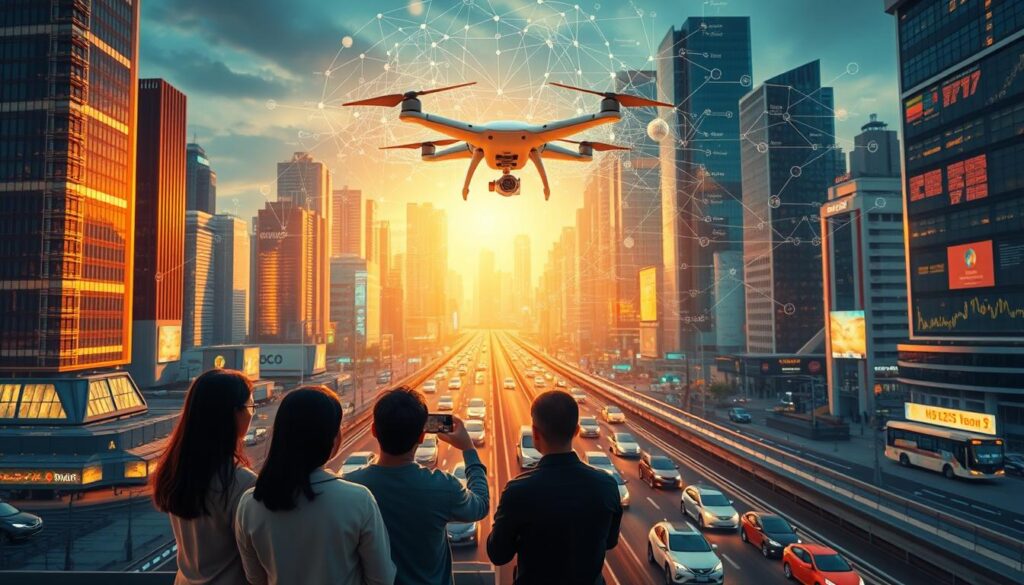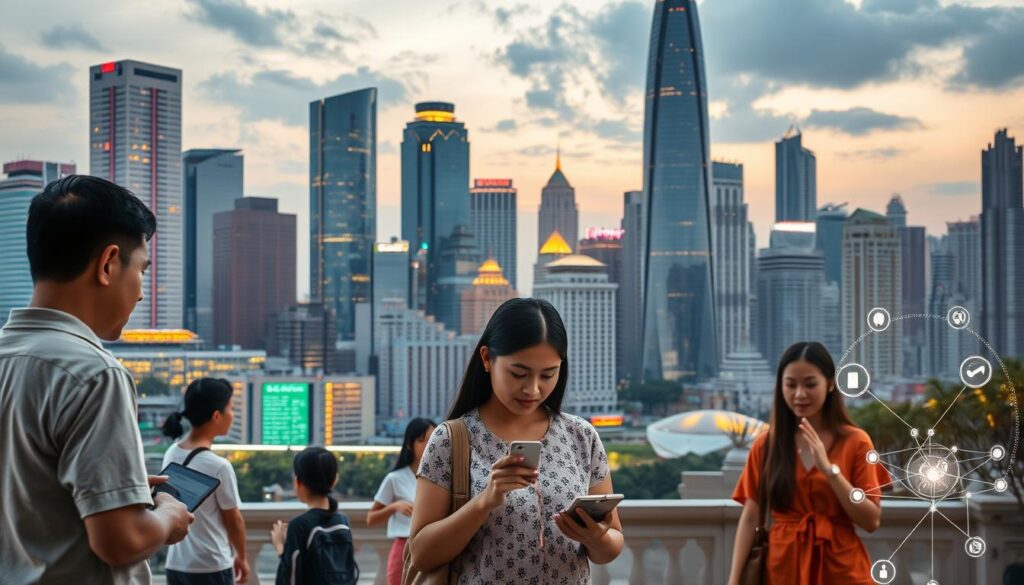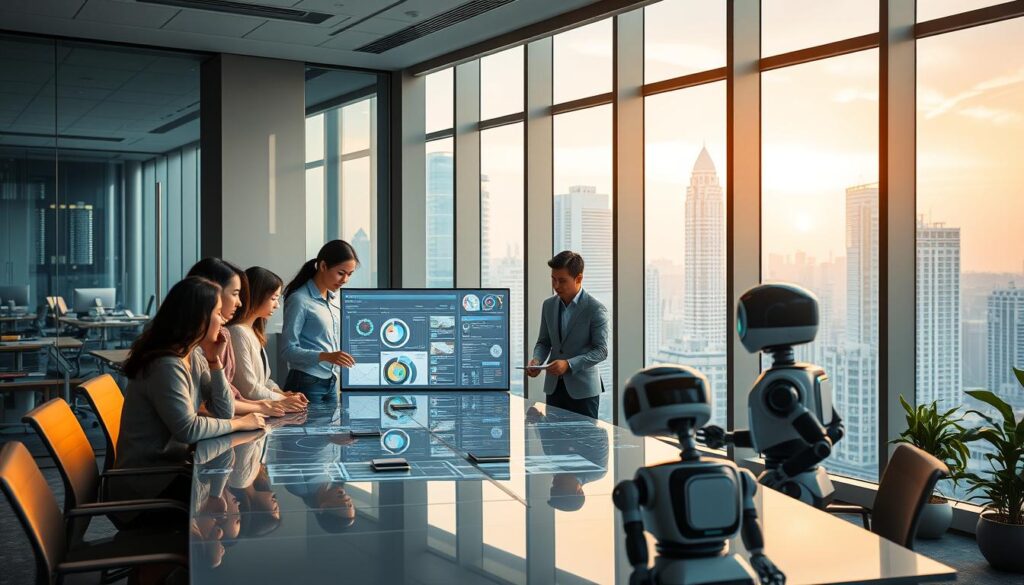As the digital world keeps changing, a big question is: Are businesses using Artificial Intelligence and the Internet of Things to their fullest? This mix, known as AI IoT integration, is changing industries and opening up new chances for innovation, mainly in the Philippines. With the AI market expected to grow by 40% by mid-2024 and 16.7 billion IoT connections forecasted, it’s crucial for business leaders to understand these technologies.
In fact, 64% of businesses say AI boosts productivity, and 42% find it makes job processes smoother. This article explores why combining AI and IoT is important. It shows how these technologies can solve complex problems and improve efficiency in many areas.
The tech revolution demands that companies not just use but excel in IoT business applications and AI. By looking into how these two technologies work together, leaders can keep up with market changes and ensure their companies thrive.
Key Takeaways
- The growth of AI and IoT is set to change how businesses operate.
- AI can greatly improve business efficiency, leading to higher ROI.
- Understanding AI IoT integration is vital for staying competitive.
- Leaders must use IoT business applications to seize new chances.
- Adopting AI and IoT can bring big economic benefits to businesses.
Understanding AI and IoT: A Brief Overview
Artificial intelligence and the Internet of Things are changing how we work. They make businesses better in many ways. Knowing what they do is key to seeing their benefits.
Defining Artificial Intelligence
Artificial intelligence makes machines think like humans. It includes things like machine learning and talking computers. These systems learn from data, find patterns, and predict outcomes. This helps make better decisions and work more efficiently.
What is the Internet of Things?
The Internet of Things connects devices over the internet. It’s used in many fields, like farming, health care, and shopping. From smart homes to industrial sensors, it collects lots of data. This data leads to new ideas and better services.
How AI and IoT Work Together
When AI and IoT team up, they become even more powerful. AI helps IoT by making sense of all the data. For example, AI can help save up to 30% by managing resources better.
Together, they make things run smoother and faster. This means better work and more done in less time.
The Importance of AI and IoT Integration in Business
AI and IoT together change how businesses work. They make things more efficient and productive. AI looks at lots of data from IoT devices to find important insights. These insights help make better decisions and improve how things are done.
Boosting Efficiency and Productivity
AI can analyze data fast, which is great for things like predicting when machines will break down. It helps keep operations running smoothly. For example, smart thermostats learn what you like and save energy.
In factories, AI helps predict when equipment might fail. This means less time when things aren’t working. It’s all about keeping things running smoothly.
Enhancing Decision-Making Processes
AI and IoT together give companies deep insights. For example, self-driving cars use AI to make quick decisions about traffic. This shows how data can lead to fast actions.
In healthcare, AI watches over patients with wearable devices. It alerts doctors to any problems. This means doctors can act fast to help patients. It’s all about making things better for everyone.

Key Industries Benefiting from AI and IoT
AI and IoT are changing many industries. They make processes smoother and improve performance. Companies using IoT solutions see big gains in manufacturing, healthcare, and retail. Each field benefits in its own way, showing the broad impact of this tech mix.
Manufacturing Sector Innovations
Manufacturing has seen big changes, like smart factories. IoT sensors watch how things work in real time. This keeps machines running well.
AI helps guess when machines might break down. This cuts downtime by up to 30%. It also keeps production high, making things more efficient.
The Healthcare Revolution
Healthcare is changing fast with AI. It makes diagnosing diseases like pneumonia and tuberculosis faster and more accurate. Wearable tech and AI help track health in real time.
This helps manage long-term health issues like diabetes better. AI makes treatment plans that fit each person. This leads to better health and lower costs.
Retail Transformations
Retail is getting a boost from AI and IoT too. It offers shopping experiences that fit what each customer likes. This means better matches for what people want to buy.
Prices can change based on what’s happening in the market. This helps stores make more money. AI also helps manage stock, predicting what will sell. This reduces waste and keeps things running smoothly.
Examples of Successful AI and IoT Integration in Asia
The mix of artificial intelligence and the Internet of Things has changed many areas in Asia. Companies use smart IoT devices in new ways. This boosts productivity, cuts costs, and helps the environment. Here are some examples from different fields showing how AI and IoT data analytics work together.
Smart Agriculture Solutions
In farming, smart IoT devices are changing how we grow food. They check soil moisture, temperature, and nutrients. This lets farmers make better choices based on data.
For example, sensors give updates on how crops are doing. This info is used to improve watering and fertilizing. AI can also predict how much will be harvested. This helps farmers use less and grow more.
Transportation and Logistics Improvements
The transport sector gets a lot from AI and IoT. Smart devices track shipments as they move. This info, mixed with AI, makes routes better and saves fuel.
AI also helps predict when vehicles might break down. This stops problems before they start. By using IoT data, companies can see how well they’re doing. This helps them get things to customers faster.
Energy Management Systems
In energy, AI helps figure out how much we use and how to use it better. Smart devices watch how much energy we use. This cuts down on waste.
Companies can set up systems that change how much energy they use based on what’s needed. This makes things run more smoothly and helps the planet.
| Industry | Application | Benefits |
|---|---|---|
| Agriculture | Soil and crop monitoring | Optimized yields and resource efficiency |
| Transportation | Real-time shipment tracking | Improved route efficiency and reduced costs |
| Energy | Consumption analysis | Sustainability and cost reduction |
Challenges in Implementing AI and IoT Solutions
Companies trying to use AI and IoT face big challenges. These include keeping data safe and setting up the right infrastructure. It’s important to tackle these issues to make AI and IoT work well.
Data Security and Privacy Concerns
More IoT devices mean more data security worries. Studies show 63% of companies see security risks as a big problem. Sensitive data moves around, making it hard to keep it safe from hackers.
About 60% of businesses say data privacy stops them from using AI and IoT. But, 90% plan to use AI for better cybersecurity. This is to protect their IoT networks from threats.
Infrastructure and Connectivity Issues
Getting AI and IoT to work together is hard. About 70% of IoT projects fail because of compatibility issues. This shows how tough it is to link different devices and systems.
IoT devices will create a huge amount of data, about 175 Zettabytes by 2025. 80% of companies struggle to handle this data. They need strong infrastructure to manage it all and keep devices connected.
The Future of AI and IoT in Southeast Asia
AI and IoT are changing Southeast Asia’s cities. They are turning into smart cities. This means better monitoring of buildings and services.
These changes will make cities more efficient. They will affect traffic and waste management.
Emergence of Smart Cities
Smart cities in Southeast Asia will use AI and IoT. For example, traffic will be better with real-time data from cars and buses. Singapore is already leading in this area.
AI will help plan cities better. It will make life easier and less crowded.
Growth in Mobile and Cloud Technologies
Mobile and cloud tech are growing fast. They help share data in real-time. This boosts creativity in IoT projects.
Companies like Grab and Gojek use AI to improve services. They make things better for users and work more efficiently.

Investment in AI is increasing in Southeast Asia. This helps tech startups and big companies grow. It could add ₱57.6 trillion to ASEAN’s GDP by 2030.
Companies that use these technologies will be more productive. They will also compete better globally. As 70% of companies use AI for efficiency, the region will grow.
For more insights on implementing AI effectively for small businesses, check out this resource.
Developing an AI and IoT Strategy for Your Business
Creating a strong strategy for AI and IoT in business needs deep understanding. AI strategies should tackle challenges and boost efficiency. Leaders must look at current processes and see where AI and IoT can add value.
Identifying Business Needs
Knowing what a business needs is key. A thorough analysis can reveal gaps and chances. Companies should see how IoT can solve problems, like predictive maintenance or inventory management.
They should also think about how AI can improve decision-making. This leads to better operations.
Setting Goals and Objectives
Clear goals are crucial for a smooth implementation. Businesses must set targets that match their strategy. They might aim for better customer service or more efficient operations.
Using data insights to track progress is important. Looking at ROI measurement sources can help make these goals sharper.
Choosing the Right Technology Partners
Choosing the right tech partners is vital for success. Working with experts in AI and IoT is key. They bring the latest tech and best practices.
Businesses should look for partners that offer support and insights. This helps in using AI and IoT to grow the business.
Tools and Platforms for Seamless AI and IoT Integration
Businesses are now using AI and IoT more than ever. They need good tools and platforms to integrate these technologies smoothly. This helps them work better and stay flexible.
Popular IoT Platforms in Asia
In Asia, many IoT platforms are becoming popular. They help connect devices and manage data.
- AWS IoT: This platform offers great connectivity and data analysis tools. It lets devices talk in real-time.
- Microsoft Azure IoT Hub: Azure has strong tools for big IoT projects. It makes managing devices and data easy and safe.
- Google Cloud IoT: Google’s platform is all about machine learning. It helps businesses make sense of lots of data from devices.
- IBM Watson IoT: IBM Watson is known for its deep analysis. It helps companies use data for better maintenance and efficiency.
AI Solutions Tailored for Business Needs
There are many AI solutions for different business needs. They help improve how things work and make customers happier.
- In manufacturing, AI predicts what inventory is needed. This helps avoid stockouts.
- Healthcare uses AI with wearable tech to check patient health from afar. This leads to quicker help.
- Retail uses AI to guess what customers will buy. This helps manage stock better.
- AI helps drones in farming check soil health. This gives farmers tips for better watering.
With so many IoT devices coming online by 2025, companies that use these platforms will do better. They’ll keep their equipment running and improve how they work.

Case Study: A Leading Asian Company’s Success with AI and IoT
A leading Asian company shows how AI and IoT can make a big difference. This case study looks at how they improved their operations step by step. Businesses can learn a lot from their success with AI and IoT.
Overview of the Implementation Process
The company started by figuring out what they needed to improve. They used AI and IoT to make their processes better. Here are the main steps they took:
- They checked their current setup.
- They picked partners who were experts in AI and IoT.
- They trained their staff on the new tech.
- They tested the new systems in small projects first.
Measurable Outcomes and Impact
The results were amazing. Here’s what they found:
| Outcome | Percentage Improvement |
|---|---|
| Operational Efficiency | 10% better |
| Cost Savings | 6.6% less spent |
| On-Time Delivery Rate | 8.5% more on time |
| Revenue Growth | 1.6% more money made |
These changes show how AI and IoT can really help businesses. The company is still using these technologies to get even better. Other companies can follow their lead to improve and grow.
The Role of Government in Supporting AI and IoT
The government is key in helping AI and IoT grow in the Philippines. It starts many projects to boost innovation and use of these new techs. By working with private companies, the government helps bring these technologies to life. It also makes sure the networks are safe and secure.
Initiatives in the Philippines
In the Philippines, many efforts are underway to use AI and IoT in government services. These projects aim to make decisions better, services more efficient, and people more involved. A study found that 317 articles talked about how AI and IoT can improve government work by using data.
Public-Private Partnerships
Working together, public and private sectors can make AI and IoT work better in government. This teamwork helps share resources and skills. It also keeps data safe as new tech is added.
By combining public needs with private innovation, the Philippines can use AI and IoT in many areas. This includes better managing transportation and saving energy.

Skills and Knowledge Required for AI and IoT Adoption
Businesses need a skilled team to adopt AI and IoT. They must know how to use AI and IoT together. This is key for success.
Upskilling Your Workforce
Companies should train their employees to keep up with digital changes. Training in AI and IoT helps workers understand data, machine learning, and security. This way, they can help improve business efficiency and productivity.
Continuous Learning and Development
Learning never stops in tech. Companies should encourage a culture of learning. Working with schools helps create training that meets business needs. This boosts individual skills and helps the company grow.
Focus on improving skills and learning keeps companies ahead. By investing in workforce development, they can use AI and IoT to their fullest potential. This approach helps them succeed in a world of innovation.
| Key Skills | Importance |
|---|---|
| Data Analytics | Facilitates informed decision-making and predictive insights. |
| Machine Learning | Enhances automation and efficiency in various processes. |
| Cybersecurity | Protects against vulnerabilities associated with connected devices. |
| Project Management | Ensures successful implementation of AI and IoT projects. |
| Interpersonal Skills | Promotes collaboration across departments and teams. |
Conclusion: Embracing the Future of AI and IoT in Business
The mix of AI and IoT is a big chance for businesses to grow. By 2030, these techs could add ₱864 trillion to the global economy. Leaders must see how important it is to use AI and IoT well to stay ahead.
They should invest in good plans and train their teams. This is key to using these techs right.
Key Takeaways for Business Leaders
The IoT market is expected to hit ₱63.36 trillion by 2026. Companies need to start using these techs now. Using AI and IoT well can cut costs by 30% in healthcare or 40% in other areas.
Leaders should focus on training. There’s a 70% skill gap in using AI and IoT right.
Final Thoughts on The Potential Impact
The future of AI and IoT is huge for many industries. They will change how we do business a lot. By 2025, we’ll have 75 billion connected devices.
For businesses in the Philippines and everywhere, using these techs is crucial. It will make them more productive and change how they work.

